You’ve done your research, done your preparation, and collected your puppy. Now it’s just a matter of sitting back and enjoying your puppy, right?
How can such a cute little bundle of fluffiness suddenly become a bear trap on legs?!
Before we move on, let me offer you some reassurance:
- You are not alone. In fact, most dog owners will have their own puppy biting nightmare to contend with
- There is nothing wrong with your puppy
- There are things that you can do to cope
So, if you have a case of the puppy biting blues and want to find out how to get a puppy to stop biting – read on.
Affiliate Disclaimer
1 Teeth in Puppies and Dogs
In order that we may better understand our puppies and, therefore, the associated Puppy Biting Nightmare, let’s become more familiar with teeth in puppies and dogs.
1.1 Number of Teeth in Puppies and Dogs
Let’s talk numbers:
- A puppy has 28 teeth
(deciduous teeth – also known as primary, baby, or milk teeth) - An adult dog has 42 teeth
(permanent teeth – also known as secondary or adult teeth)
… and more numbers:
- Incisors – 12 in a puppy and 12 in a dog
- Canines – 4 in a puppy and 4 in a dog
- Pre-molars – 12 in a puppy and 16 in a dog
- Molars – none in a puppy and 10 in a dog
1.2 Function of Teeth in Puppies and Dogs
OK, so we’ve seen how many teeth our puppy has (and will have) but what do the different types actually do?
Incisors
These are the smaller teeth at the very front of your puppy’s mouth. They form a neat, little row.
The name derives from the Latin incidere which means “to cut”. Basically, they are used to cut and scrape food. When your puppy is trying to get the final, little pieces of meat from a bone he will scrape at them with his incisors.
Canines
These are the big, distinctive, pointed teeth (sometimes called fangs) that typically first catch your attention when you see a dog’s teeth. They sit on either side of the incisors.
They are used for tearing (primarily in food but also, if necessary, in a fight).
Pre-Molars
These follow on after the canines and, as the name suggests, before the molars.
They are used for chewing food (or anything else that the puppy turns it’s attention to!) and breaking it into smaller pieces.
Molars
And finally, at the back of the mouth, are the molars. Note that these are only present in adult dogs, your puppy will not initially have any molars.
These are the ‘grinding’ teeth, breaking food down into a manageable size before being swallowed.
If you take a look below at the picture of my dog, Harvey, you should be able to spot the different types (although his tongue is blocking some from view!).
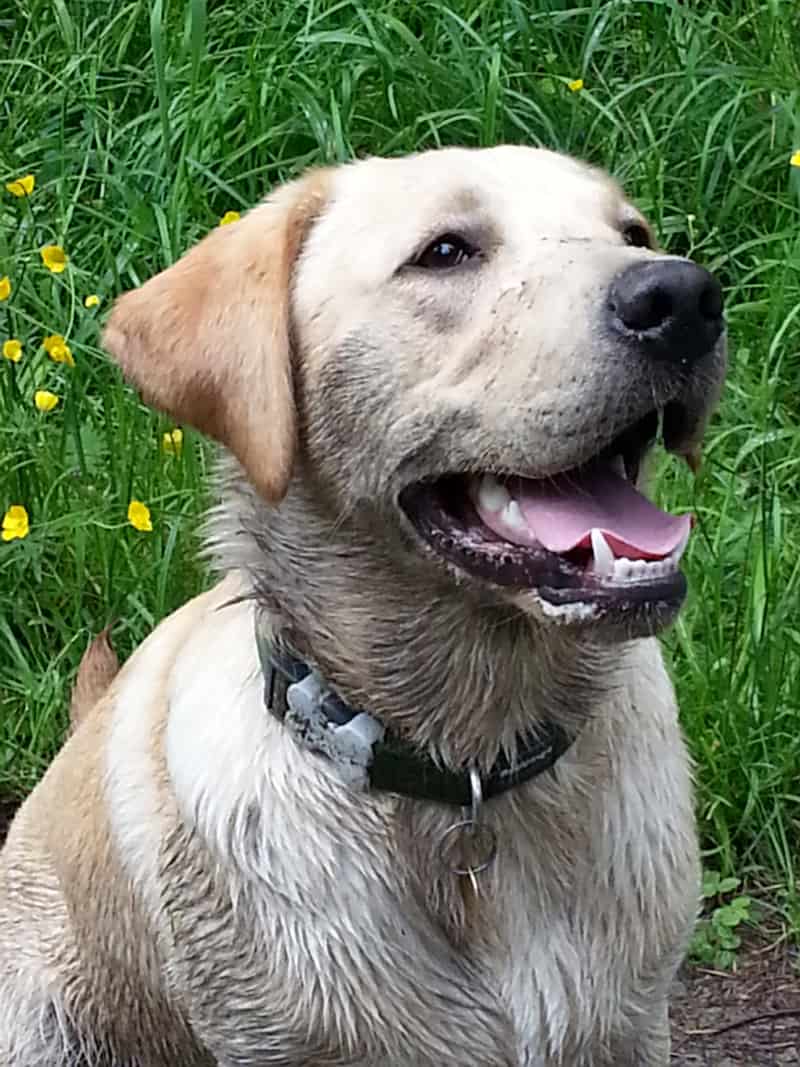
There will be times when you don’t care that your puppy has 28 teeth, consisting of 12 Incisors, 4 Canines, and 12 Pre-Molars. You will just know that he has a mouthful of little needles that he seems intent on sinking into your flesh or attaching to your clothes.
The Puppy Biting Nightmare has begun!Read on to see when that time will arrive …
1.3 Stages of Puppy Teething
These are just guidelines. The actual timing will vary between dogs of different sizes (larger dogs typically get their teeth sooner) and different breeds.
That said, the stages can be broadly summarised as follows:
- Puppies have no teeth when born
- 2-4 weeks – teeth begin to appear
- 6-7 weeks – a full complement of 28 deciduous teeth
- 3-4 months – the deciduous teeth start to fall out
- 6-7 months – a full complement of 42 permanent teeth
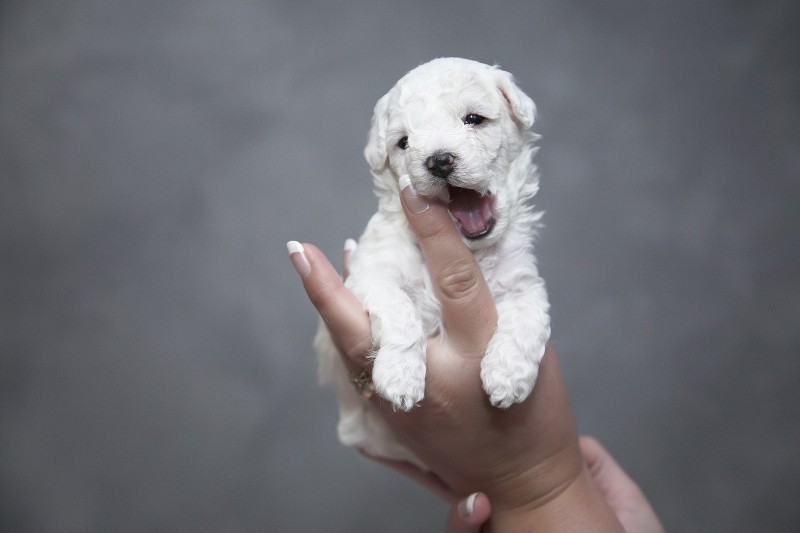
So, given that the recommended age for collecting your puppy is 8 weeks he should already have a full set of deciduous teeth when you take him home.
And when the teething stage starts, don’t worry if you don’t actually find any deciduous teeth – the Puppy Tooth Fairy has taken them!
Seriously, though, you may not find many/any because it is very common for puppies to swallow the teeth.
2 Why is my Puppy so Nippy?
“Why does my puppy keep biting me?”
So says pretty much everybody who has ever had a puppy.
Well, there are two main reasons:
2.1 Puppy Teething
So, in the absence of little teeth scattered around your home as if from some canine horror movie, how will you know when your puppy is teething?
- You may notice missing teeth in your puppy’s mouth
- And the gums may be swollen and look sore
- There may be some drooling
- And small spots of blood on his toys
- In some cases, there may also be a loss of appetite
- But, most of all, your puppy will be chewing on absolutely everything in an attempt to help him cope with the discomfort that he is feeling
And it’s this last one that is a source of puppy biting nightmares for so many people.
As difficult as it may be when he is latched on to your hand, trousers, or furniture, try to have some sympathy for your puppy. He isn’t doing this to hurt or annoy you. He’s simply trying to relieve the discomfort that he is feeling.
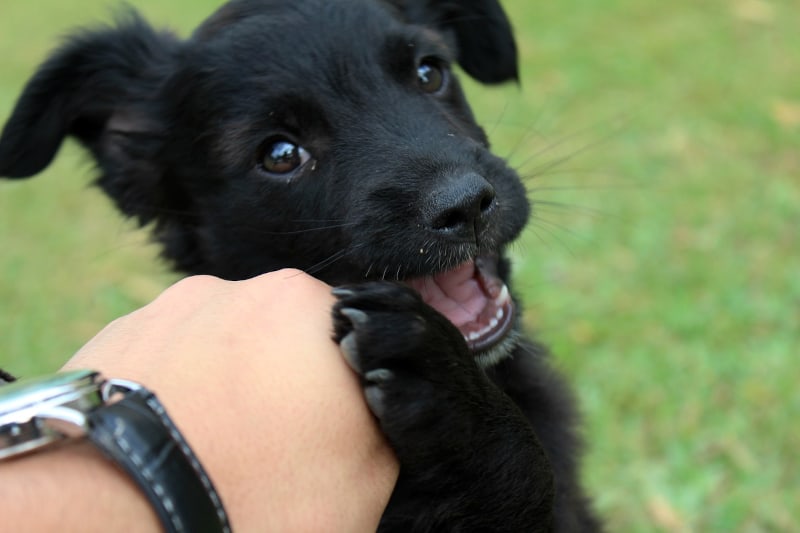
2.2 Puppy Exploring
Puppies are curious.
They like to explore.
They explore places, other animals, and all manner of objects.
What do you usually do when you want to examine something in more detail? Well, depending on what it is, you’ll often pick it up.
And you’ll pick it up with your hands (unless you have a particular reason for not wanting to use your hands!).
Guess what? Puppies don’t have hands!
So, like toddlers, when they are exploring they’ll often do this by picking an object up in their mouth. Or, if it’s too big or awkward – just giving it a bit of a chew!
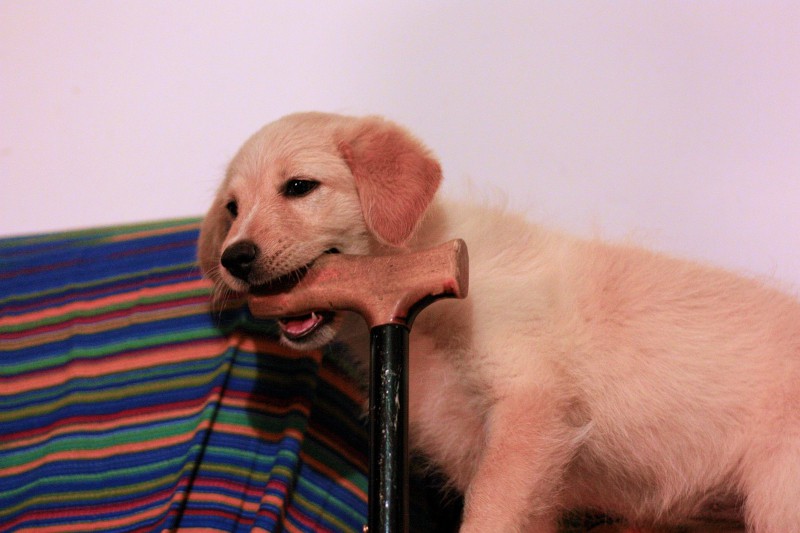
3 Bite Inhibition
3.1 Measuring Bite Strength
So, if a dog or puppy bites you, just how strong is that bite?
Firstly, we need to understand that there is a difference between:
- Force – this is basically pushing or pulling something
- Pressure – this is a measure of how much force is applied to a particular area
Let’s say, for the sake of argument, that Tom Cruise weighs 150 pounds (around 10 1/2 stone for those of us who still think in Imperial measurements or around 68 kg for those of you who have moved with the times!).
If Tom were to tread on your foot he would be applying a force of 150 pounds.
You probably wouldn’t experience much pain.
Now, imagine that Tom puts on his favourite stiletto shoes. And treads on your foot again.
That is going to hurt!
Why?
Because that 150-pound force is now being concentrated into a much smaller area. That is, the pressure has increased substantially.
Can you see where I’m going with this?
Dog’s teeth are very well suited to applying a lot of pressure to a bite.
3.2 Bite Strength Comparisons
Just for comparison purposes, let’s have a look at the bite strength of a few animals.
| Crocodile | 3,700 psi |
| Lion | 1,000 psi |
| Human | 150 psi |
Now, the bite strength of dogs varies hugely by skull shape and size. As you might imagine, Marvin the Mastiff can bite with more force than Charlie the Chihuahua.
A Mastiff has a bite strength of around 550 psi.
Show a little caution when reading articles about the strength of dog bites. You know the type “Monster Pitbull bite strength is 2,000 psi!!!“
Really?! Twice that of a lion?
In a blog post on this issue, Stanley Coren explains how these articles are, how shall I put it, working on incorrect assumptions.
Where does that leave us in terms of puppy biting?
Well, once a puppy has its first teeth in, it could apply enough pressure to crush the bones of a human finger. Yes, that finger that your puppy keeps biting!
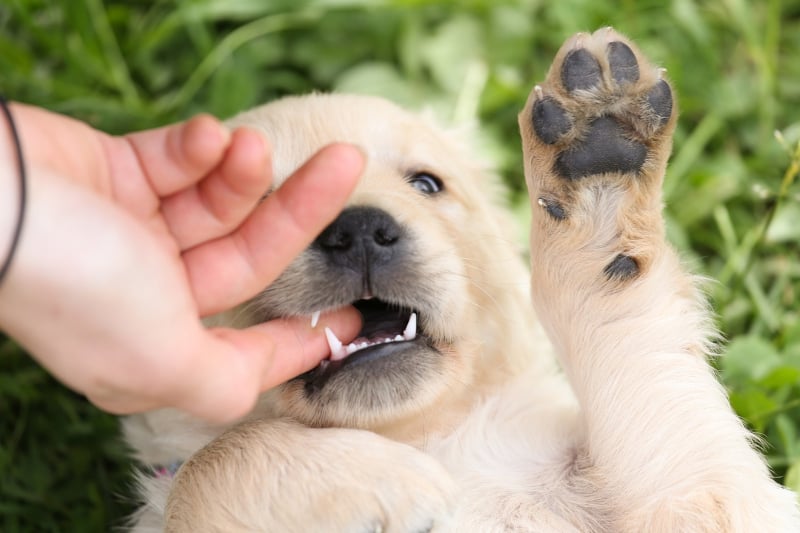
3.3 Bite Inhibition – Puppy Self-Restraint
So, having discovered that your puppy could crush the bones in your finger when he is biting you, are you thinking?:
- AAArrrrrrggggghhhhh!!! Killer puppy! Killer puppy! Run for your lives!
or … - Wow. What remarkable self-restraint. What a clever puppy I’ve got.
Are you still with me?
I thought so. You seemed like the option 2 type of person.
And the reason that your puppy isn’t crushing your finger?
Because he has learned and is continuing to learn, bite inhibition. That is, he is learning that he doesn’t need to, and shouldn’t, bite with the full power available to him.
This is a vital skill for puppies to master. We don’t want our puppy, or worse still our adult dog, to be unaware of how hard is too hard when it comes to biting.
For dogs that have learned bite inhibition as puppies, it is very rare, even when provoked, for them to bite with the full force that is available to them.
Imagine if your puppy didn’t practice in these various scenarios. How would he know how hard to bite? Might he get it wrong and bite too hard?
And practice really does make perfect. Labradors, like our lovely Harvey, can be particularly mouthy as puppies but are then incredibly soft-mouthed as adults. Something to do with their being bred to carry game (without damaging it) perhaps.
So, when you see your puppy playing with another puppy and he is biting – don’t immediately rush in and take him away. He is learning! (Of course, you must still watch to make sure he doesn’t get carried away).

And the same goes for interaction with adult dogs too.
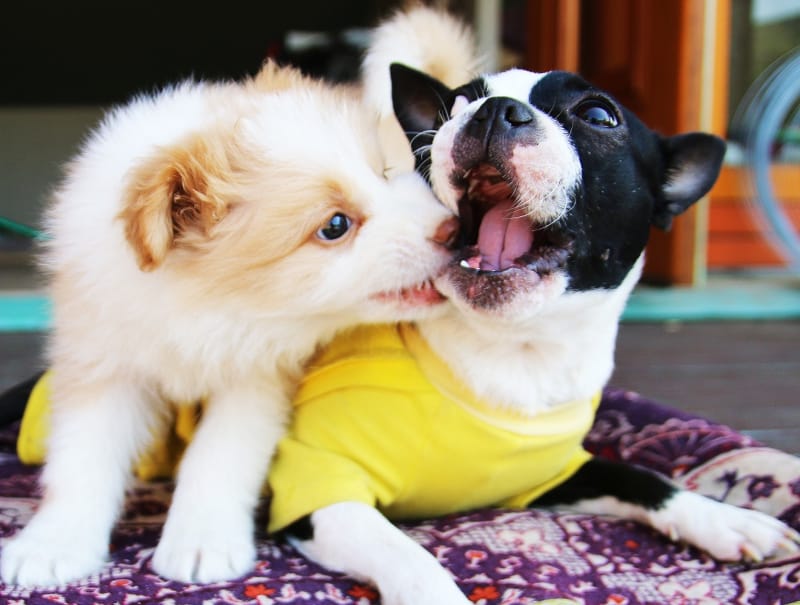
4 Stop Puppy Biting
OK, so, armed with this knowledge, we now have a better understanding of what is driving our puppies’ behaviour.
And we are, perhaps, better placed to answer the questions posed by so many puppy owners during this phase. Things like:
- Why is my puppy so nippy?
- Why does my puppy keep biting me?
- When will my puppy stop biting me?
- Why does my puppy keep biting my clothes?
“All well and good” you may be thinking “but …”
Let’s look at how to get a puppy to stop biting.
4.1 Check for Problems with Your Puppy’s Teeth
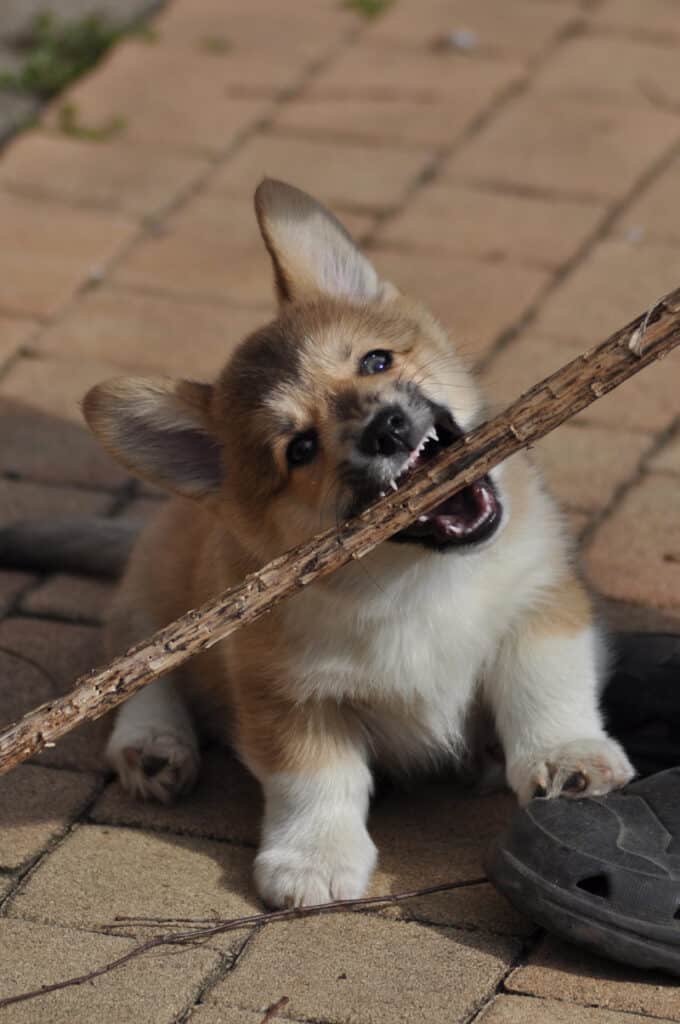
Before we look at how to train your puppy to stop biting, we need to ensure that there aren’t any health issues (which no amount of training can resolve!).
The vast majority of puppies get through the teething stage with no complications whatsoever.
However, your puppy is in your care so it pays to regularly check him over for any health issues and, if you are in any doubt, consult with your vet.
In this case, it pays to check on your puppy’s teeth to make sure that there aren’t any problems. Remember how we discussed how many teeth a dog should have? Time to start counting teeth!
What we are looking for is a retained tooth (or teeth). If you find that your dog has too many teeth then speak with your vet about extraction as surplus teeth can causes problems.
You should also take the opportunity to look for any chipped or cracked teeth which can also cause problems (as well as being painful for your puppy).
Checking your puppy’s teeth at this age is part of a good puppy socialisation plan. It gets them used to having their teeth examined (good for vet visits) and used to having them cleaned (good for the long-term health of their teeth).
4.2 The “OUCH” Debate
When a puppy is playing with other puppies, or even with adult dogs, he will sometimes get a bit carried away and bite too hard. The bite will often elicit a yelp of pain from the unlucky recipient.
It was speculated that this lets the puppy know that the bite was too hard. That is, that it was part of learning bite inhibition.
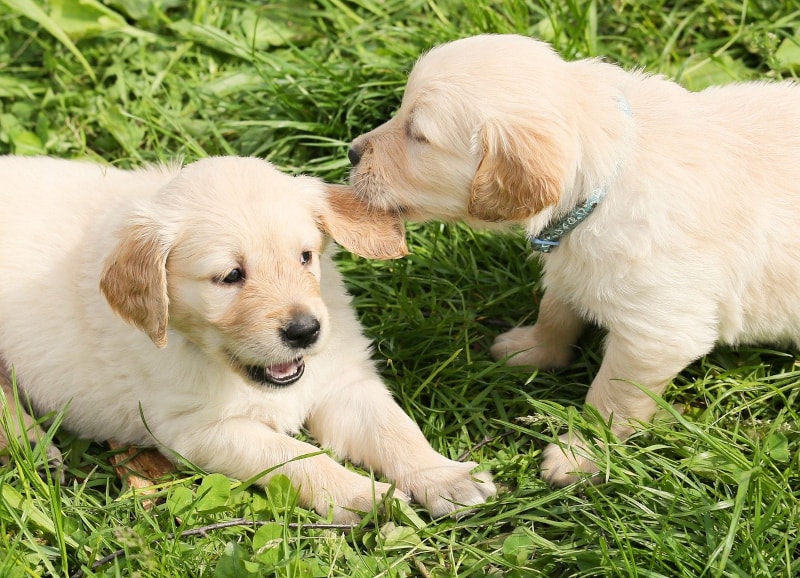
Many trainers and organisations latched on (sorry, couldn’t resist!) to this concept and thought that it could be extended to interactions with humans.
For example, the advice from the ASPCA became:
“When you play with your dog, let him mouth on your hands. Continue play until he bites especially hard. When he does, immediately give a high-pitched yelp, as if you’re hurt, and let your hand go limp. This should startle your dog and cause him to stop mouthing you, at least momentarily. (If yelping seems to have no effect, you can say “Too bad!” or “You blew it!” in a stern voice instead.)”
ASPCA article
Now, there is a certain amount of logic to the “Ouch” approach so it’s difficult to fault this advice. Except that – it doesn’t work!
- Research by Sarah Whitehead and her team found that not once did puppies stop biting each other after one of them yelped. Details of the study are included within Sarah’s course Puppy Biting & Bite Inhibition.
- Rather than encouraging the puppy to stop biting, shouting out may actually excite him and encourage him to bite more.
- Or, worse, you may actually scare him and make him fearful of approaching you.
- We’re setting the puppy up for failure. Rather than waiting for an action that we don’t want and then reacting negatively, we should be looking for ways to discourage the biting in the first place.
Depending on your age, you may well remember a YouTube video in which the failure of the “Ouch” approach in human youngsters was, painfully, demonstrated by Charlie and his brother.
Right, that’s established what we shouldn’t be doing because it doesn’t work.
Let’s now look at what we should be doing!
4.3 Preparing the Ground for Success
In order for our “Stop Puppy Biting” training to be most effective, there are things that we need to do or take into account before we begin the training.
- Don’t encourage your puppy to bite.
You, and your puppy, might find it an enjoyable game but it’s just not fair on him.
Imagine that a child, or an adult for that matter, goes to stroke your puppy and your puppy thinks it’s playtime … and bites them. It may well be a fairly gentle bite but most children, and some adults, tend to over-react to such things.
At best, you’ll have a screaming child and an angry parent. Your puppy will pick up on this and it is likely to impact on his behaviour and training.
At worst, you may be accused of having a dangerous dog. I kid you not. Some people are either afraid of dogs or just don’t like them and will seek to use the available legislation against you.
Either we want to discourage biting or we don’t – you can’t have it both ways! - Don’t play ‘rough’ games.
Of course, you’ll want to play with your puppy. And you should, puppies are incredibly endearing at the best of times but when they are playing their enthusiasm is a joy to behold.
However, you should not engage in rough play with him. No getting him so wound-up and excited that he starts biting clothes or body parts.
Don’t confuse your puppy by telling him he can’t bite and then encouraging him to do that very thing! - Be Prepared!
As you’ll remember from the Collecting a New Puppy post, part of your preparation for having a puppy is making your house and garden safe for him.
This includes putting away things that your puppy may be tempted to chew on. Expensive shoes or handbag left lying around on the floor? Those are fair game for a puppy whose teeth are causing him discomfort.
Don’t wait until you see him running around with these items in his mouth (or, worse, ripping them to shreds!) and then shout at him. Put them away and avoid the situation.
4.4 Redirecting Your Puppy’s Biting
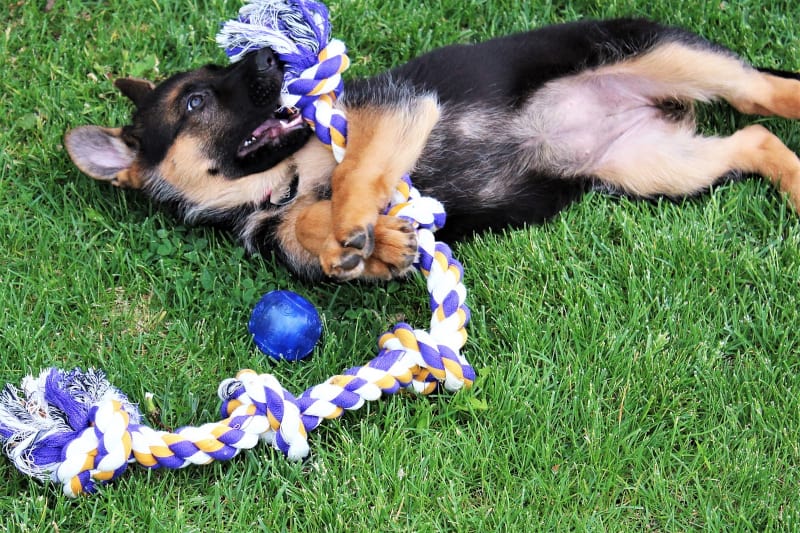
In many martial arts, a guiding principle is the redirection of an opponent’s attack. Now, I’m not suggesting that you and your puppy start doing your training at a dojo, but we can make use of the redirection principle.
The next time that your puppy starts biting your hand, encourage him to bite something else instead. Preferably, something specifically designed for the purpose like some Nylabone Puppy Teething Rings. Or perhaps a Nylon Rope Toy.
This allows your puppy to obtain the teething relief that he craves without inflicting damage to you or your clothes.
We used the teething rings with Harvey when he was a puppy and he loved them. In fact, he used them so much that we had to buy a second lot!
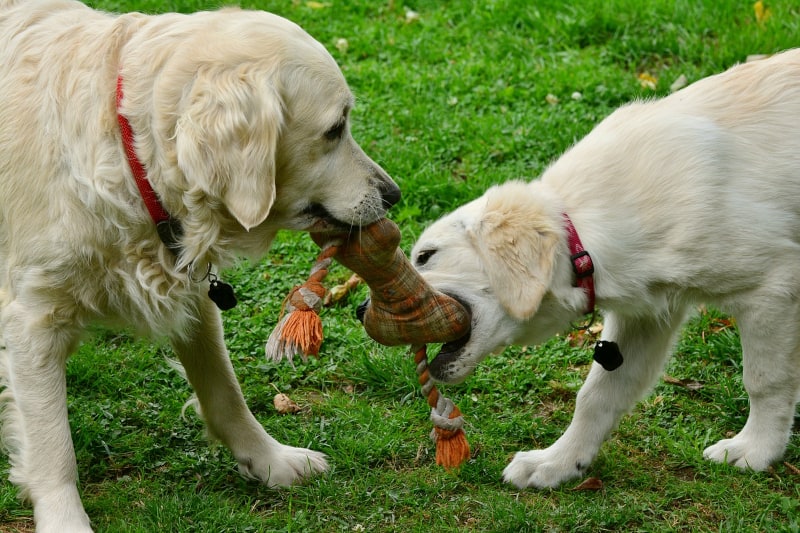
4.5 Keep Calm and Carry On
Puppies are excitable creatures.
And the more excited they get, the more likely they are to bite.
When Harvey was young I remember my sister and young niece visiting. “Can me and Harvey go outside?” enquired my niece.
“Of course,” I said “but you need to keep calm. No screaming or shouting. No waving your arms around in the air. No running.”
“OK” she said.
You’re way ahead of me here, aren’t you? I’ll continue for the few that aren’t …
In less than a minute we hear my niece screaming. Closely followed by seeing her running past the patio door, waving both arms in the air. With a very excited young Harvey in hot pursuit!
So, you need to monitor your puppy’s excitement levels. If he is getting too wound-up by a particular game or activity, or by attention from a person or dog, then it’s time to intervene before he bites.
This is why the “Ouch” method described above doesn’t always work. Some puppies pay no attention to it. Others become even more excited and so you risk making the situation worse rather than better.
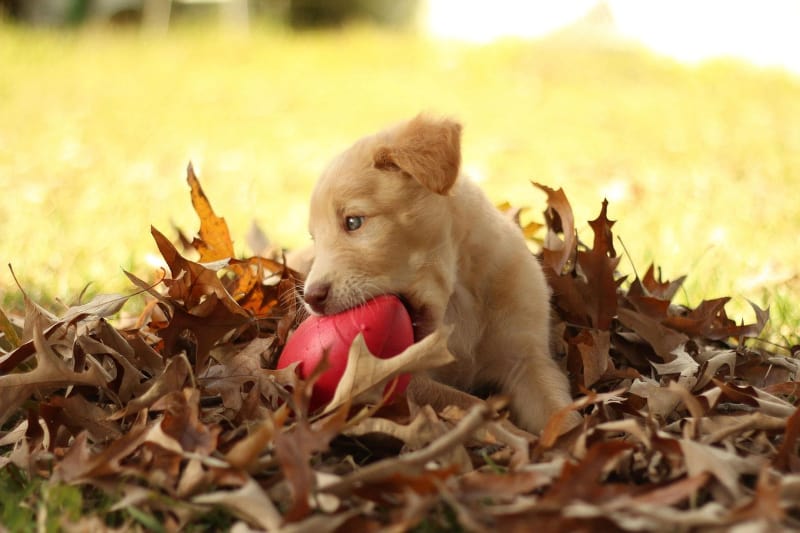
When you begin to train your puppy I’d recommend that you use Positive Dog Training methods and trainers that support that approach.
The basic premise of this is that ‘What gets rewarded, gets repeated.”
In other words, if you give your puppy a reward for doing something then he is more likely to repeat that behaviour in the future.
Now, rewards don’t necessarily come in the form of treats. Your puppy could be rewarded just by having your attention on him (in fact, many dogs find this more rewarding than treats!).
Can you see where I’m going with this?
So, if your dog bites you (or somebody else). You should not give him attention. No shouting. No disapproving glares. No deep exhalations of breath. No laughing. If you were already giving him attention then remove it.
A study by Naoko Koda demonstrated that, with Guide Dog puppies and their walkers, this approach was effective for stopping the puppies from biting the walkers.
You could do this by gently placing him in his crate for a short period (no more than 1 minute or so). However, the very act of picking him up could be construed as giving him attention.
Furthermore, there is a risk that this could result in your puppy having a negative association with his crate and we don’t want that.
A better approach is to simply leave the room. This is an especially good approach if you have invested in a stair-gate as you can remove your attention but still be able to keep an eye on your puppy.
In fact, we found the stair-gate so useful that we still have it (even though Harvey is nearly 7 years old). It’s so handy to use if there is a visitor at the door who may be wary of dogs. Or if you need to bring stuff into the house from the car and don’t want to worry about the dog taking the opportunity to visit the neighbours without an invite!
Finally, keep an eye out for puppy training saboteurs!
All of your efforts can easily be undone if somebody else is reinforcing the puppy’s biting behaviour. Be it deliberately engaging in rough play or unintentionally giving attention. Play as a team!4.6 Drop It and Take It
How cool would it be if, when your puppy started biting something that he shouldn’t, you could simply say “Drop It” … and your puppy would, indeed, drop it?
Well, you can!
You’ll need the following:
- A puppy that is rested and has recently relieved itself (you don’t want a puppy that is too tired to concentrate nor one that needs to toilet).
- A toy that your puppy likes to engage with.
- Some tasty treats (sufficiently tasty to trump playing with the toy!)
OK, start by sitting on the floor with your puppy. This avoids the need for you to lean over him – avoiding both the potential for him feeling threatened and the possibility of you injuring your lower back!
Hold the toy in your left hand and engage with your puppy in the same way as you would if you were going to play with him. Move the toy around to make sure he has a good grip on it, as if you were having a game of tug.
Then take a treat in your right hand and bring it towards your puppy’s nose. As soon as he lets go of the toy, give him the treat.
Remember the positive dog training approach that I mentioned earlier? This is what we are using here. In your puppy’s mind, we are creating the link that dropping the toy results in receiving a tasty treat.
Keep repeating this process for a while to help strengthen that link.
Once you are happy that the link is firmly established, it’s time to add a cue. You can use whatever word or words you like but it’s usually best to keep it simple with either “Drop It” or just “Drop“.
At the same time, we can also introduce the chosen cue for the puppy taking the item in the first place. Again, keep it simple with something like “Take It“.
So, start the process again. This time, as you entice your puppy to take the toy, say “Take It”. And when he takes it, you move it around in the mini-tug game. And every time hereafter that you want him to take a toy, you say “Take It” first.
Then, you say “Drop It” and move the treat in front of your puppy’s nose.
The next step is to be able to say “Drop It”, wait for your puppy to drop the toy, mark the behaviour (see below), and then reward with the treat.
Marking is the method we use to let our puppy or dog know that the behaviour they have just completed is the one that we are looking for. We can use a clicker, designed specifically for this purpose, or we can use a simple verbal marker like “Yes!” or “Good!”.
You’ll need to evaluate whether your puppy is able to move on to this step straight after the initial training or whether it is preferable to bank the progress you have made so far and start again when your puppy is fresh.
Don’t overdo any training with your puppy. Better to have four 5-minute sessions spaced throughout the day than one mammoth 20-minute session. Keep it fun!
For an excellent demonstration of how this works take a look at the video below by Emily “Kikopup” Larlham.
Got it? Good. Now a little caveat for you!
Dogs are brilliant at responding to trained cues. But not so good at understanding the potential implications of their actions.
On holiday in Brixham one year my wife and I took Harvey for a walk to a local beach. “It’s lovely and secluded” we had been told, “… but a quite steep descent to get there.”
Quite steep!?
A Mountain Goat in its prime would, I feel, have considered it to be somewhat more than “Quite steep”!!
Anyway, we carefully made our way down to the beach and, to be fair, it was, indeed, quite secluded.
Two of Harvey’s favourite things are a tennis ball and swimming. So, we had a great time throwing a tennis ball into the sea for him to fetch and return to us (and repeat!).
After a while, having enjoyed the beautiful scenery and, we hoped, sapped some of Harvey’s surplus energy, we decided it was time to return to our holiday accommodation for something to eat.
We looked at the ascent away from the beach.
We looked at each other.
“Oh crap!” we said in unison.
It looked steep from the top of the hill. It looked like a Herculean task from the bottom!
Harvey still seemed to have more energy than a toy rabbit powered by a certain brand of copper-topped batteries, so we set off with Harv leading the way.
We zigged. We zagged. We stopped to catch our breath!
Eventually, after much zigging, zagging, and stopping to catch our breath, we were nearing the top. And at this point, I had a sudden thought.
“Did you pick up the tennis ball?” I asked my wife.
“No. I thought you had.” she replied.
I looked at Harvey and saw that he hadn’t forgotten the tennis ball. He’d quite happily carried it in his mouth and climbed up the hill without all the huffing and puffing that we had.
“Thank goodness for that” I said “… whatever you do now, Harv, don’t drop it.”
You’re way ahead of me again, aren’t you?
That’s right. Harv didn’t hear (or, rather, didn’t understand) all of the non-cue words that left my mouth. All he heard was “Drop It“.
So he did!
And off went the tennis ball, down this ridiculously steep hill!!
Harv looked pleased with himself. And why wouldn’t he? He’d done exactly what I asked him to do. He was probably wondering whether he might get a treat as a reward!
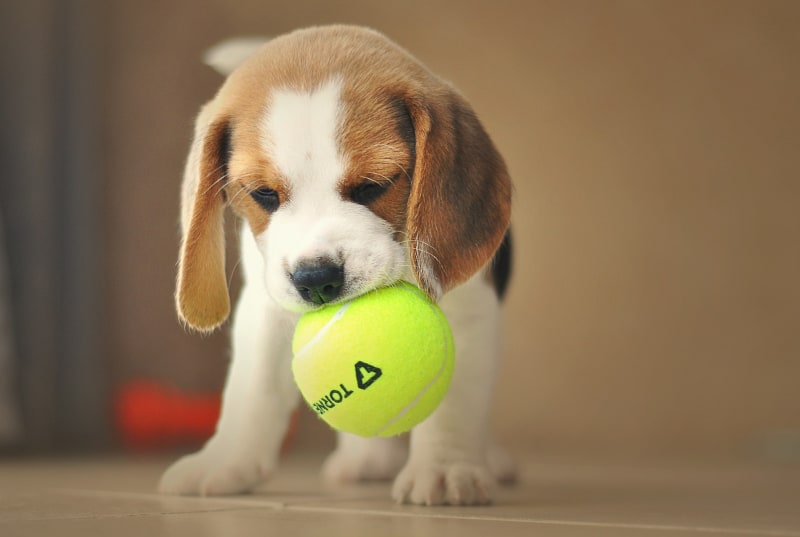
4.7 Stop Puppy Biting Clothes
After “Why does my puppy bite me?” I think the next ring in puppy biting hell is probably “Why does my puppy bite my clothes?“.
I remember that when Harvey was a puppy he managed to ruin a number of items of clothing before we figured out what we needed to do.
I also remember marveling at his bite strength even then. He would latch on to the bottom of one leg of a pair of jeans and you could (carefully, so as not to hurt him) keep walking and he’d be there hanging on like the world’s smallest and cutest guard dog!
Now obviously we don’t want this behaviour to continue. It’s annoying, or even frightening, for guests and it gets expensive too in terms of replacement clothing.
So, how do we get our puppy to stop biting our clothes?
Firstly, keep in mind that ‘tug’ is a fantastic game to play with your dog. We want to be able to do this both now and in the future. BUT – you need to use a cue so that your puppy knows when it’s OK to do it.
As before, keeping it simple is likely to be the best approach. “Take It” when you want your puppy to take the offered toy and “Tug” when you want to engage in a game of tug.
Secondly, we’re again going to use positive dog training to reward our puppy for offering the behaviour that we want. So, grab your tasty treats (when I say ‘your tasty treats ‘ I mean your puppy’s tasty treats, not a chocolate bar or packet of crisps!), and let’s start.
- Have an old item of clothing to use as the item to be ignored and sit on the floor with your puppy, the clothing, and the treats.
- Pick up the clothing and move it slowly (we don’t want too much temptation yet).
- Immediately, before the puppy can act, mark the action (remember? a clicker or a verbal marker like “Yes” or “Good”) and reward it with a treat.
- Repeat a few times, gradually increasing the time before marking, until the puppy is clearly comfortable with ignoring the item.
- Then start to move the clothing closer to the puppy. Mark. Reward.
- Then gradually move the clothing a little faster (not too fast, too soon – we want the puppy to succeed, we don’t want him to fail). Mark. Reward.
- Once he is happy with this, move on to using clothing that you are wearing, like a sleeve or trouser leg. Again start off slow – help the puppy to win! Mark. Reward.
At this point, it’s evaluation time again.
Have you made good progress? Is your puppy’s attention starting to wane? Consider ‘banking’ this successful session and starting the next part in the next session.
Remember, puppies tire easily at this age so don’t make your training sessions too long.
If your puppy is still eager for more training, or you are starting the next session, we now want to move on to working with a standing ‘target’ (that’s you!).
Slowly lean over, close to your puppy, and move the old item of clothing around at puppy level. Mark and reward your puppy for not biting the clothing. (As with the seated training, do this quickly initially – help the puppy win!)
Gradually increase the temptation (clothing closer, clothing faster, delayed marking).
Then move on to worn sleeves and trouser legs.
Finally, remember what we learned in the “Redirecting Your Puppy’s Biting” section. If you see your puppy is about to bite somebody else’s clothing then immediately attract his attention and provide an alternative object for him to bite.
Here’s a video of the always brilliant Emily “Kikopup” Larlham demonstrating how to stop your puppy biting your clothes:
4.8 Physical Punishment
It sounds horrible to most of us, I know, but there are still some people who think that the best way to teach anything to a puppy (or dog) is by punishing it physically.
A short message for those people :
If you’d like to know more about why it isn’t the best approach (and I really hope that you do) then please take a look at the Positive Dog Training post.
5 Puppy Biting Nightmare – Final Thoughts
I’d like to finish this post by leaving you with some final thoughts:
- You WILL wake from your Puppy Biting Nightmare!
- There is nothing wrong with your puppy. Believe it or not, this biting phase is ‘normal’
- Your puppy is not aggressive. Even if he barks, and growls, and snarls. He is just playing
- Teething is uncomfortable and painful – have some sympathy for your puppy
- You can minimise the impact of puppy biting by following the basic ground rules …
- … and using appropriate training techniques
- Keep puppy training sessions short and frequent. Don’t overdo it – let the puppy have plenty of sleep
6 Frequently Asked Questions
How do you Stop a Puppy from Biting?
The first thing to do is to establish some ‘ground rules’.
1. Don’t encourage biting.
2. Don’t play rough games.
3. Prepare your house and garden so that it is a safe environment.
Once you have those in place, consider these training approaches.
1. Use redirection – divert your puppy’s biting away from his choice of target to one of your choosing (like a toy).
2. Keep calm. Excited puppies are more likely to bite. Use brief time-outs to avoid giving attention to biting behaviour.
3. Teach ‘Drop It’, and ‘Take It’, so that you can get the puppy to drop inappropriate items that he may have picked up.
How do I get My Puppy to Stop Biting My Clothes?
Use Positive Dog Training to gradually increase your puppy’s self-control around things (like clothes) that he finds tempting.
Start with low-temptation scenarios, mark the successful completion of non-biting behaviour (with a clicker or a verbal marker like “Yes”), and then reward with a tasty treat. Slowly increase the level of temptation until your puppy can happily ignore the temptations that he faces.
Why Won't My Puppy Stop Biting Me?
There are two main reasons why a puppy bites:
1. When they are teething, puppies attempt to alleviate some of the discomfort that they are feeling by chewing things. If you don’t want that to be you then look to redirect his attention on to other things (like chew toys).
2. In case it has escaped your attention, your puppy doesn’t have hands! In order to further explore the things that he discovers he is likely to use his mouth. This helps to establish the texture of the object, its weight, how easy it is to carry, and so on.
How Longs does Puppy Biting Last?
Puppies’ deciduous (baby) teeth start to fall out between 3-4 months of age. And they should have a full complement of permanent (adult) teeth by the time that they are 6-7 months old. The exact timings will vary for each puppy.
So, in the scheme of things, not all that long. If you are having a Puppy Biting Nightmare and feel that this is too long then look at the various training options that are available to stop puppy biting.
7 Acknowledgements
And …
8 The End
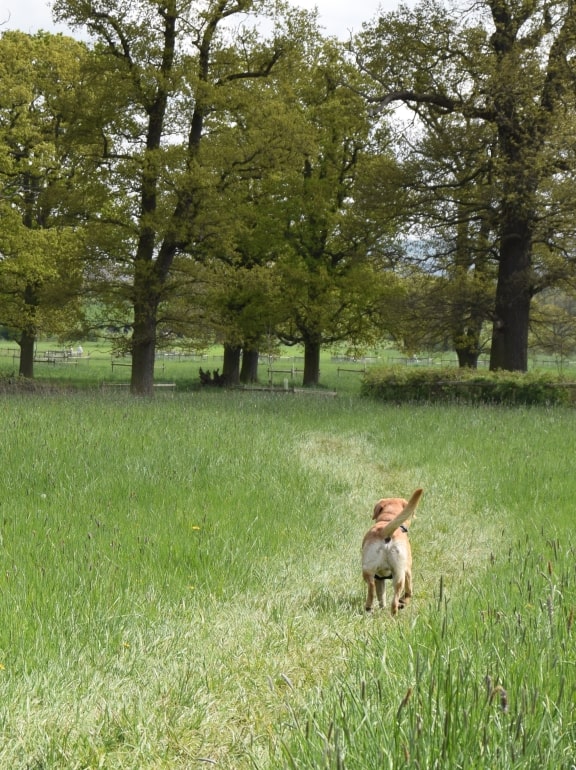
I hope that you’ve enjoyed this post.
Feel free to navigate around the site to see if there is anything else that may be of interest to you.
If you liked this post please share it. Thank you 🙂
If you’d like a heads-up when the next post is issued sign-up to the Richie’s Room Newsletter.
And, if you’d like to add a comment that would be great too – you can do that below.
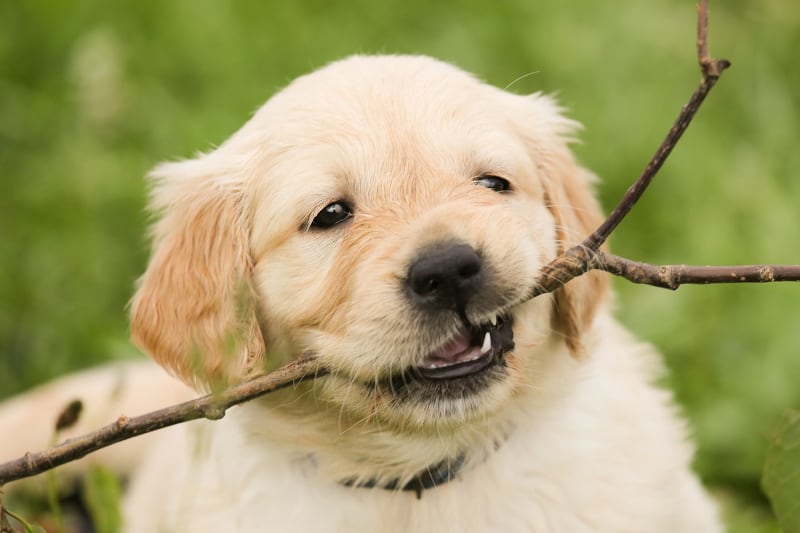
Wow, what an extremely detailed write-up! You’ve got all kinds of background, and really consider the problem from all the angles. I love your compassionate tone throughout – both for the puppies and their new families who might not be having the easiest go of things. We go into puppy parenting with such rosy expectations, but it really is a LOT.
Really cool piece of content that you could spin into an ebook – you have most of the scaffolding there for it already!
Hi Sam. Thank you very much for your positive feedback, it’s very kind of you.
I loved this. Thank you for sharing your words
I remember when Mr Buster was a puppy. Oh my god that boy would chew any wood garden furniture we had aha.
However you still love them!
Xoxox
Hi Libby. Thank you for your comment. Yes, they can be little monsters at times, but we still love them.
Hey Richie, all this puppy talks makes me want to get a puppy and I haven’t had one in about 10 years lol.
Thanks for sharing these great and helpful tips on puppy biting. Many of these things I never even considered before when I had puppies.
Hey Rebekah. Thanks for your feedback. Well, I’d say that you are long overdue a new puppy then 🙂
I love your blog! Super helpful post as always. All these things broke, my now 3 year old, puppy from biting.
Hi Alexis. Hearing that people love my blog makes all the effort worthwhile – thank you.
Wow this was an excellent post on puppy biting. Very thorough! I must admit that reading this made me miss my boys, Otis and Larry (they were Pugs). They’ve long passed on, but I still wish they were alive. 🙁
Great work on this blog! 🙂
Thanks, Kiley, that’s great to hear. I hope that you have fond memories of Otis and Larry.
I remember when my dog used to bite the carpet off our stairs every morning, we had to have it re-done after a year 😂
Hi Lisa. Yep, if you don’t choose something for them … they’ll make their own choices 🙂
Thank you for sharing this! Super helpful post as per!
Amber – The Unpredicted Page
Hi Amber. Thank you, appreciate it.
Once again, this is interesting, detailed and most of all, useful. Thanks for sharing.
Hey Graham. Glad that you found it useful.
Good post! Very informative. I learned a lot about dogs from reading this post. Thank you for opening up my world. Your blog is awesome. Pls keep on sharing this kinda post.
Hi Fadima. Thank you for your kind words.
Such great info. Our little doggo isn’t a puppy any more but if we get another puppy will have to save this info for later. Thanks for sharing.
Hey Greg. I’m glad that you enjoyed it.
I love exploring the Animal kingdom……
And I love dogs so much…..
These are some information that I’ve never heard before….
Thank you for sharing this Valuable information 😇
JENISH
Hi Jenish. Thanks for your comment (and I love dogs too!)
Wow – what a fantastic article. I’ve learnt a lot from this article and I wish it’d been around for me to share with my Dad when he got his puppy, Henry (a cocker spaniel who is now 5 and akin to a giant cuddly teddy bear). He was rather boistrous as a pup and my Dad bought a Cesar Milan book to help with his training…He never got to read it as by the time he arrived home the book had been torn to pieces by Henry! I like to think it was his way of showing exactly what he thought about the Dog Whisperer.
Anyway, he’s an absolute delight now. So placid and well behaved. You’re right, the puppy biting nightmare didn’t last forever!
Hi Vicky. Thank you so much for your comment. I’m pleased to see that Henry exhibited good taste in reading material from the outset!
If I ever get a dog again, which I hope to at some point, then this will be really useful. I don’t remember how it was done with my childhood Border Collie as it was so long ago, haha!
Hi Molly. I’m glad that you found the post useful. Would you have a Border Collie or something different?
Hi Richie, what a lovely dog-themed blog! I don’t have a dog at the moment but used to live with an older lady and her sweet pup when I was still studying. It was so lovely, I do miss having pets, but it’s just not practical in a London apartment. Your tips are super helpful for anyone with a dog.
Hi Kathrin. Thank you for your kind words. I know what you mean about apartments – depending on your time commitments, you could always look at walking dogs for rescue centres. Just a thought …
Found this post as a suggestion in a Twitter comment. I’ve read some part and bookmarked remaining as the post is quite big. I love reading such thoroughly written articles.
Regards, BloggerFire.com
Hi there, glad you found us!
This is such a great post! Next time I get a puppy it will be great knowing all this. Thanks for sharing!
Hi Kristy. I’m glad that you liked it. Thanks for your comment.
Oh i can imagine it’s such a challenge. I will bear this in mind if i get a puppy!
Hey Chris. Thanks for the comment.
This is at the same time the most informative and most hilarious post I think I have ever read! Although our Very Good Boy is well past the biting stage, there’s certainly a new puppy coming at some point in our future. (Because a home without a dog…) I will certainly be refering back to this article when that time comes. Thank you for both the info and the laughs!
Hi Lori, thank you for your kind words. If I’ve managed to both educate and entertain then I’ll consider that a job well done!
Thank you for the tips. These did help with my 10 week old. What about a puppy who likes to bite on rocks? I’m just afraid he is going to crack his teeth.
Hi Heather. Thanks for your comment. I don’t know what it is about pebbles/rocks but most puppies seem to go through this phase – perhaps its a texture thing. Anyway, the best approach here is a strong Drop It cue – use the technique detailed in the post. Let me know how you get on.
If I keep reading your posts, I’m going to have to get a dog. 🙂 Adorable pictures, by the way.
Hi Michelle. Well, that’s a good thing isn’t it? 🙂
Most of the pictures are from the generous photographers at Pixabay – if you ever need pictures for your blog, give them a try.
So much great indepth info, will deffo be saving for reference when I get my puppy. Really useful, thanks for sharing
Hi Nicola. Thank you for your comment – much appreciated.
Super helpful post! We don’t have a dog but I’m desperate to get a puppy and as soon as we’ve moved into suitable accommodation we hope to get one! I hope I remember all your great advice on this. It makes so much sense. Plus the pictures of the puppies were SO cute!
Hey Emma. I’m glad that you enjoyed the post. That’s great to hear – I wish you luck with your hunt for suitable accommodation.
Thanks for all your tips! We may look at a younger dog when our large almost 8yo girl leaves us for the Rainbow Bridge (hopefully not soon!)
Hi Jennifer, thanks for your feedback. Puppies are lovely but I hope that your next one is some way off yet (8 isn’t old)!
This was a really interesting post; and something I haven’t seen around! I was quite young when our family got our first puppy (I think around 8?) so can’t remember the pain of puppy teeth but I do remember us purchasing lots of puppy teething toys which we could put in the fridge so they were nice and cool and alternated them regularly for her so she didn’t end up causing too much damage! Our other dog we adopted from a rescue centre when he was 2 so skipped that stage. Thanks for sharing such a great resource!
Hi Paige. Thank you, your feedback is greatly appreciated. Yep, distraction with teething toys is very effective 🙂
Both of our dogs were biters when they were puppies. They’ve long since broken the habit, but it does have you worried about how to break the habit before they get too big and can do real damage. Fortunately, it was all in play, but we were able to get them to the point where they didn’t want to chew on people but rather their toys! 🙂
Hi Anthony, thanks for your comment. Using appropriate toys is certainly the way to go.
I’m saving this post. My husband and I are looking to adopt another dog. However, we are not sure if we want to adopt a puppy or an adult, but this is great information regardless since I know people who are looking to adopt or already have a puppy.
On a different note, people do need to read this and be informed on how to handle a biting/teething puppy. I have heard of puppy owners spanking or hitting the innocent pup as a training technique. Would the adults do the same of their human baby bit too hard? Most likely not.
Thank you so much for this information.
That’s great, thanks, Stacey.
You are right, there are still many people, unfortunately, who use ‘traditional’ training techniques and seem to think that it is OK to punish a puppy or dog. It’s a very slow process but I think that, gradually, more and more people are coming around to the concept of Positive Dog Training.
Such an informative and entertaining post! I have dogs for years but I didn’t know they were teething like babies. Already surpassed that stage but the puppy biting was not a problem back then. Great research!
Hey Vinn. Thank you for your comment. I’m glad that it was both informative and entertaining – that’s always the goal.
This post is full of important and helpful information to help pet owners!
Thank you for sharing.
Lauren
Hi Lauren. Thank you, I’m glad that you enjoyed the post.
Very informative post! Loved it. I remember playing tug with my pup and her baby tooth popped out. I was freaking out but then realized just like babies, they go through a teething stage as well and lose their baby ones.
Hi Amanda. Thank you – hearing that somebody loves a post is always great encouragement to keep posting.
Wow— Very informative! Would be a perfect reference for anyone with a puppy biting problem. Thanks for sharing! The pictures were really cute too. 🙂
Glad that you found it informative, Samantha. Yeah, dogs are great but puppies win on the cuteness front 🙂
What a fab post. We didn’t have much trouble with Bear teething (she’s very small though). Will defo keep this post handy if we decide to get another dog though – plenty of great tips!
Han
Hi Han. Thank you for your kind comment – much appreciated.
This is a helpful post Richie! I know friends who had puppies and went through the biting nightmare!
Hi Lucy, thanks for commenting. Yeah, most puppy owners go through it.
I wish I had read this post when my dog was a puppy. I have a female golden retriever and it looked like her favorite hobby was biting.
Thanks for your comment, Jessica. There’s always the next puppy … 🙂
This is by far the best writeup on the subject I have ever seen! My parents are getting a puppy this weekend so this will be so handy for them. I have pinned it. Great job and thanks for sharing all this info!
That’s very kind of you to say so, thanks Kadie. I hope that your parents find it useful.
This was very informative and also very interesting read for me. Thanks for sharing this.
Hi Lomash. Thank you for your comment, it is much appreciated.
Aww puppies adorable cuteness. I love Labrador puppies just squishy loveliness x
Hi Angela. Yeah, there can’t be many things as cute as a puppy (although, I think kittens are close).
I’m always amazed that people dive into getting a new pet (puppy or kitten) and then are horrified that the animal isn’t perfectly behaved (in their eyes). Human babies teethe so why wouldn’t animals? And you wouldn’t hit or shout at a human baby (at least I hope not) so again, why at your pet. This is such a great post, Richie, so helpful, full of detail! Lisa
Hi Lisa. Thanks for commenting. Yeah, it is amazing isn’t it? I think some people just aren’t cut out for pet ownership …
Wow, so much information here. We tried to teach my little guy drop from a very young age. He seemed to understand it very quickly but he was very selective about when he chose to listen to it. Thankfully he wasn’t too much of a nibbler, but we did get him a lot of teething toys, just in case.
Sophie
Hi Sophie, thanks for your comment. If Drop It isn’t working reliably then you may need to up the value of your rewards in some further training – make the reward more appealing to him than whatever he has in his mouth.
Oh man, puppies can hurt with the biting because they don’t know how to control their strength yet. Hurts even more because they’re not dulled out yet. I really appreciate the level of detail you put into this post. Great job! Thanks for sharing!
Nancy ✨
Thank you for your feedback, Nancy, it is greatly appreciated.
I actually always just thought biting was something that all puppies do. I never thought about ways to stop them from doing it!! Thanks for sharing Richie
Hi Mike, thanks for the comment. Live and learn, eh? 🙂
This is great advice! My family are actually picking up their puppy in a few weeks so I’m definitely going to save this post of them!
Hi Alex. Excellent – I hope they find it useful.
This is SO important. I have seen far too many dog owners shrug off ‘undesirable’ behaviour in their puppy because it’s cute when they are a small, only to complain when the dog has the same habits as an adult. In fact, there are many dogs that will wind up in shelters simply because their owners didn’t address habits like this at a young age.
Absolutely. Thanks for sharing your experience, Britt.
These are such great tips! I don’t have a puppy, but if I ever get one, I will keep these tips in mind! Thanks for sharing!
Thanks for your feedback, Charity.
This is a really helpful post. Thank you for sharing your tips and advice.
Hi Lauren. I’m pleased that you found it helpful. Thank you.
This post is everything! All vital information needed if you have a puppy. As a child growing up, I’ve had many puppies but often thought that my puppy (fluffy) was aggressive, but from reading this is could of just be a case where her teething process was too painful for her.
Question for you: what’s your view on teacup puppies? I’ve done some research on this type of puppy last year as I was interested in owning one, but I started to come across many articles and video saying that breeding this type of small puppy is actually cruel. Would love to hear your thoughts on this.
Hi Rebekah. Thank you for your kind words.
The trouble with any popular type of dog breed is that unscrupulous breeders will focus more on profit and less on the welfare of the dogs. In addition, there can also be problems when a particular physical trait is considered by some to be desirable and breeders then focus on this trait to the detriment of the dog’s health. This can be seen most clearly in the case of the brachycephalic dogs, like Pugs, where the shape of their face is now so exaggerated that they often have breathing difficulties. To answer your question, I think the potential risk is that some breeders may focus on producing the smallest possible dogs, because that is popular, rather than focusing on producing the healthiest dogs. By all means get a small dog but try to ensure that you get a healthy dog. Have you thought about something like a Jack Russell? Or is that bigger than you were planning?
Wow, thanks for such a thorough post Richie. This is everything I could ever want to know about puppy biting. Somehow I didn’t realize that really young puppies didn’t have teeth. Now I feel pretty silly about that because it makes total sense. 🤷♀️ When I got my puppy from the pound she was two and a half months old but had spent one month of her life already in the pound. she hadn’t really been socialized with other puppies and she was definitely the biting nightmare that you describe. The needle teeth! The struggle is real but she did eventually stop and now is pretty good!
Hi Clarissa. Thanks for your comment. Oh yes, the needle teeth are real! Glad that you and your pup made it through 🙂
This was a really interesting post to read richie, and as always filled to the brim with information! Personally I’ve not had any puppies why I’ve been old enough to train one but this is a great resource. Im a massive cat person hahaha x
Hi Kayleigh. I’m glad that you found the post interesting – if I can appeal to both dog and cat owners then I figure I must be on the right track 😉
So needed to read this today! Puppy biting is the worst with my pup! Thank you so much for the tips!!
Hi Amanda and thank you for your comment. I know it seems bad now but it will pass 🙂
If only I read this article when my dog was going through teething! It is so overwhelming, but thankfully, doesn’t last forever. Loved reading this, xx
Hi Uni. Yes, it can be a little overwhelming, especially if you aren’t expecting it.
My little dachshund was very fond of playing with our hands when teething. They’ve got such sharp little teeth haven’t they? that being said, I’m very lucky that she didn’t take to chewing the furniture or anything. This has some amazing advice & info for newbie dog owners. Thank you for sharing Xo
Elle – ellegracedeveson
Yes, those teeth are like little needles, aren’t they? Thanks for the feedback, Elle.
I have the same nightmare like this, after I tried your solutions, it works! thanks for sharing
Hi Bob. Thank you very much for your comment – glad you had some success.